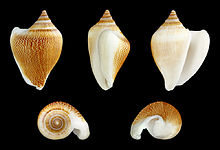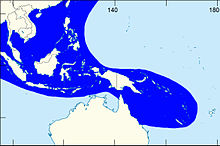
Back Bungkawil CEB Hunds-Flügelschnecke German Laevistrombus canarium Spanish صدف حلزونی سگی Persian Laevistrombus canarium French Laevistrombus canarium ID Siput gonggong Malay Laevistrombus canarium Dutch Laevistrombus canarium Portuguese Laevistrombus canarium Sundanese
| Laevistrombus canarium | |
|---|---|

| |
| Five different views of a shell of an adult L. canarium: abapertural (upper left), right lateral (center), apertural (upper right), apical (lower left) and basal (lower right) | |
| Scientific classification | |
| Domain: | Eukaryota |
| Kingdom: | Animalia |
| Phylum: | Mollusca |
| Class: | Gastropoda |
| Subclass: | Caenogastropoda |
| Order: | Littorinimorpha |
| Family: | Strombidae |
| Genus: | Laevistrombus |
| Species: | L. canarium
|
| Binomial name | |
| Laevistrombus canarium | |

| |
| The shaded area indicates the distribution of Laevistrombus canarium within the Western Central Pacific, according to Poutiers, 1998.[1] | |
| Synonyms[1][4][5][6] | |
Laevistrombus canarium (commonly known as the dog conch or by its better-known synonym, Strombus canarium) is a species of edible sea snail, a marine gastropod mollusc in the family Strombidae (true conches). Known from illustrations in books dating from the late 17th century, L. canarium is an Indo-Pacific species occurring from India and Sri Lanka to Melanesia, Australia and southern Japan. The shell of adult individuals is coloured from light yellowish-brown to golden to grey. It has a characteristic inflated body whorl, a flared, thick outer lip, and a shallow stromboid notch. The shell is valued as an ornament, and because it is heavy and compact, it is also often used as a sinker for fishing nets.
The external anatomy of the soft parts of this species is similar to that of other strombid snails. The animal has an elongated snout, thin eyestalks with well-developed eyes and sensory tentacles, and a narrow, strong foot with a sickle-shaped operculum. A molecular analysis conducted in 2006 based on DNA sequences of histone and mitochondrial genes demonstrated that Laevistrombus canarium, Doxander vittatus, and Labiostrombus epidromis are closely related species. The dog conch exhibits behaviours common among the Strombidae, including burrowing and a characteristic leaping form of locomotion. The former behaviour, however, involves movement sequences unique to this species.
L. canarium lives on muddy and sandy bottoms, grazing on algae and detritus. It is gonochoristic and sexually dimorphic, depending on internal fertilization for spawning. Larvae of this species spend several days as plankton, undergoing a series of transformations until they reach complete metamorphosis. The maximum life span is 2.0 to 2.5 years. Predators of this snail include carnivorous gastropods such as cone snails and volutes. It is also a prey species for vertebrates including macaques, and also humans, who consume the soft parts in a wide variety of dishes.
The dog conch is an economically important species in the Indo-West Pacific, and several studies indicate that it may be suffering population declines due to overfishing and overexploitation. Malacologists and ecologists have recommended a reduction in its exploitation rate; initiatives in Thailand are attempting to ensure the possibility of reproduction in young-adult individuals and manage the natural populations in general. L. canarium demonstrates the imposex phenomenon, but is resistant to sterility caused by it; therefore, this species might be useful as a bioindicator for organotin pollution monitoring near Malaysian ports.
- ^ a b Cite error: The named reference
Poutierswas invoked but never defined (see the help page). - ^ Cite error: The named reference
LinnaeusSNwas invoked but never defined (see the help page). - ^ Issel, A.; Tapparone-Canefri, C. M. (1876). "Studio monografico sopra gli strombidi del Mar Rosso". Annali del Museo Civico di Storia Naturale di Genova (in Italian). 8: 337–366.
- ^ Cite error: The named reference
Cob4was invoked but never defined (see the help page). - ^ Man In 'T Veld, L. A.; De Turck, K. (1998). "Contributions to the knowledge of Strombacea. 6. A revision of the subgenus Laevistrombus Kira, 1955 including the description of a new species from the New Hebrides". Gloria Maris. 36 (5–6): 73–107.
- ^ Cite error: The named reference
maxwellwas invoked but never defined (see the help page).
© MMXXIII Rich X Search. We shall prevail. All rights reserved. Rich X Search